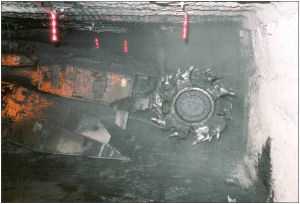Mining Topic: Respirable Dust
What is the hazard?
The extraction, crushing, and transport of coal in mining operations can generate significant amounts of airborne respirable coal dust. In metal, nonmetal, stone, and sand and gravel mining operations and for select occupations in coal mines, the generation of respirable silica dust during mining is the primary concern.
How are mineworkers affected?
Inhalation of respirable coal dust can lead to coal workers' pneumoconiosis (CWP), a disabling and potentially fatal lung disease. Inhalation of excessive levels of silica dust can lead to silicosis, another disabling and potentially fatal lung disease. Recent surveillance data indicates that the prevalence of CWP is on the rise following a 30-year downward trend. Also, mining accounted for approximately 23% of the reported silicosis deaths in the 1990s.
What is the NIOSH Mining program approach to the problem?

Continuous mining machine equipped with wet head technology.
Reducing respiratory diseases in miners is one of the top-level goals of the NIOSH Mining program's strategic plan. To achieve this objective, we conduct research to develop improved dust control technologies, which can be used to reduce the mine workers' respirable dust exposure. Four key components of this dust research program include:
- intramural engineering control research;
- technology transfer;
- funding of extramural research projects; and
- improved dust monitoring capabilities.
NIOSH Mining's ongoing intramural research addresses dust control problems in both the coal and metal/nonmetal mining industries. MSHA compliance sampling data is analyzed to identify occupations at high risk for exposure to elevated dust levels. Laboratory and/or mine-site research is then conducted to identify and evaluate dust control technologies for these high-risk occupations. The unique, full-scale dust laboratories in Pittsburgh are used by NIOSH dust researchers to evaluate technologies under controlled conditions that are not present at operating mine sites. Control technologies proven successful in the laboratory then undergo final evaluation at operating mine sites.
Publications as part of our technology transfer efforts include two recently published handbooks "Best Practices for Dust Control in Coal Mining" and "Best Practices for Dust Control in Metal/Nonmetal Mining." Mine operators can use these handbooks to identify successful control technologies that can be implemented at their respective mines to reduce worker exposures. Our researchers have also conducted a series of "best practices" workshops in mining regions around the country. Videos of the presentations related to dust controls for coal mining and slide presentations for metal/nonmetal mining are available for download from the NIOSH Mining website. We have recently partnered with the Industrial Minerals Association-North America (IMA-NA) to produce a dust control handbook that summarizes control technologies addressing all phases of mineral processing operations.
NIOSH Mining funds extramural research in areas that can have a direct impact on the reduction of dust levels in mining operations. In addition to ventilation research, basic research examines concepts such as the potential of utilizing particle charging and the wetting characteristics of respirable dust particles to improve their capture.
Real-time monitoring of respirable dust exposures enables mine operators to identify potential overexposures and implement interventions to prevent these overexposures. The personal dust monitor (PDM) is a real-time dust monitor that was developed by NIOSH through intramural and extramural research over the last decade. Extensive NIOSH testing has demonstrated that the PDM is an accurate dust sampler, and MSHA has specified that the PDM will be used for compliance dust sampling in its proposed respirable dust regulations, which are in the final stages of the rulemaking process. The PDM is a research-to-practice success story and demonstrates the impact of NIOSH research.
See Also
- Benchmarking Longwall Dust Control Technology and Practices
- Best Practices for Controlling Respirable Dust in Coal Mines
- Best Practices for Dust Control in Coal Mining
- Best Practices for Dust Control in Metal/Nonmetal Mining
- Coal Dust Exposure and Mortality From Ischemic Heart Disease Among a Cohort of U.S. Coal Miners
- Continuous Miner Spray Considerations for Optimizing Scrubber Performance in Exhaust Ventilation Systems
- Control of Respirable Dust
- Dust Control Handbook for Industrial Minerals Mining and Processing
- Equivalency of a Personal Dust Monitor to the Current United States Coal Mine Respirable Dust Sampler
- EVADE Software - 2.0
- Evaluating Portable Infrared Spectrometers for Measuring the Silica Content of Coal Dust
- Evaluation of Face Dust Concentrations at Mines Using Deep-Cutting Practices
- Evaluation of the Approach to Respirable Quartz Exposure Control in U.S. Coal Mines
- Evaluation of the Wet Head Continuous Miner to Reduce Respirable Dust
- Field Evaluation of Air-blocking Shelf for Dust Control on Blasthole Drills
- Investigation into Dust Exposures and Mining Practices in Mines in the Southern Appalachian Region
- Key Design Factors of Enclosed Cab Dust Filtration Systems
- Laboratory and Field Performance of a Continuously Measuring Personal Respirable Dust Monitor
- A New Leak Test Method for Enclosed Cab Filtration Systems
- Reducing Dust Exposure from Contaminated Work Clothing with a Stand-Alone Cleaning System
- Page last reviewed: 2/24/2017
- Page last updated: 9/22/2015
- Content source: National Institute for Occupational Safety and Health, Mining Program


 ShareCompartir
ShareCompartir